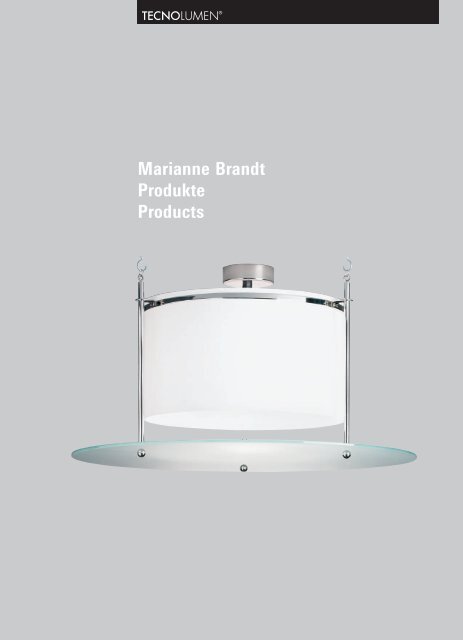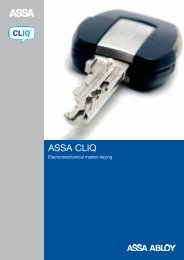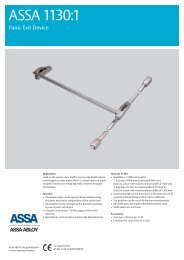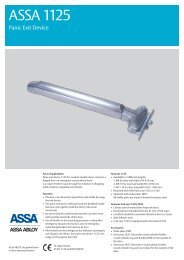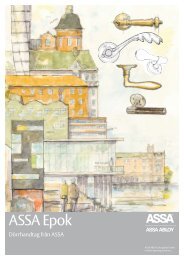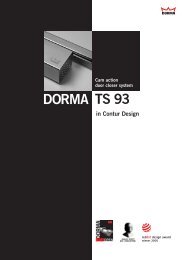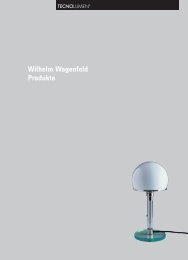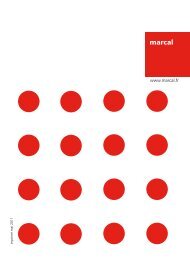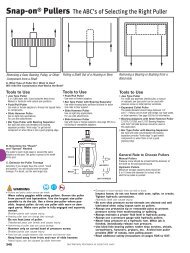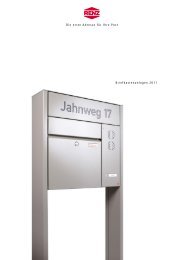Erfolgreiche ePaper selbst erstellen
Machen Sie aus Ihren PDF Publikationen ein blätterbares Flipbook mit unserer einzigartigen Google optimierten e-Paper Software.
TECNOLUMEN ®<br />
<strong>Marianne</strong> <strong>Brandt</strong><br />
<strong>Produkte</strong><br />
Products
2 Biografische Daten Biographical data<br />
<strong>Marianne</strong> <strong>Brandt</strong><br />
1893<br />
geboren in Chemnitz.<br />
1911<br />
Beginn des Malerei- und Bildhauerstudiums<br />
an der Großherzoglichen Hochschule<br />
für Bildende Kunst in Weimar.<br />
1919<br />
Heirat und Aufenthalt in Norwegen,<br />
später in Paris.<br />
1924<br />
Kommt im Januar als Studierende zum<br />
Bauhaus in Weimar. Nach Absolvieren<br />
des Vorkurses arbeitet sie in der<br />
Metallwerkstatt unter der Leitung von<br />
Moholy-Nagy.<br />
Bis 1928<br />
entstehen die Entwürfe der bekannten<br />
Gebrauchsgeräte und Lampen, die auch<br />
industriell hergestellt werden.<br />
1928<br />
Provisorische Leiterin der Metallwerkstatt.<br />
1929<br />
Mitarbeit im Baubüro von Gropius<br />
in Berlin.<br />
1929<br />
geht <strong>Marianne</strong> <strong>Brandt</strong> als Entwerferin<br />
an die Metallwarenfabrik Ruppelberg<br />
in Gotha.<br />
1932<br />
Rückkehr nach Chemnitz als Freie Malerin<br />
und Kunstgewerblerin.<br />
1949<br />
Dozentin an der Hochschule für Freie und<br />
Angewandte Kunst in Dresden.<br />
1951<br />
Mitarbeit am Institut für Angewandte<br />
Kunst in Berlin.<br />
1953<br />
Reise anlässlich einer Ausstellung nach<br />
China.<br />
1954<br />
In Berlin als selbständige Entwerferin<br />
für die Industrie tätig.<br />
1955<br />
lässt sie sich in Chemnitz nieder und<br />
widmet sich seitdem der Malerei und<br />
Kleinplastik.<br />
1976<br />
Übersiedlung nach Kirchberg/Sachsen.<br />
1983<br />
In Kirchberg gestorben.<br />
1999<br />
Gründung der MB-Gesellschaft in<br />
Chemnitz. Bennenung einer Straße<br />
in Chemnitz nach ihrem Namen.<br />
<strong>Marianne</strong> <strong>Brandt</strong><br />
1893<br />
Born in Chemnitz.<br />
1911<br />
Started her painting and sculptor studies<br />
at the Großherzogliche Hochschule für<br />
Bildende Kunst (Grand Duke University of<br />
Fine Arts) in Weimar.<br />
1919<br />
Marriage and residence in Norway, later<br />
in Paris.<br />
1924<br />
Comes to the Bauhaus in Weimar in<br />
January as a student. After completing<br />
the preliminary course she works in the<br />
metal workshop under the leadership<br />
of Moholy-Nagy.<br />
Until 1928<br />
Completion of the drafts for the wellknown<br />
consumer appliances and lamps,<br />
which are also manufactured industrially.<br />
Until 1928<br />
Temporary manageress of the metal<br />
workshop.<br />
1929<br />
Assistance in the Gropius construction<br />
office in Berlin.<br />
1929<br />
<strong>Marianne</strong> <strong>Brandt</strong> goes to the metalware<br />
factory Ruppelberg in Gotha as a designer.<br />
1932<br />
Return to Chemnitz as a freelance painter<br />
and applied artist.<br />
1949<br />
Lecturer at the Hochschule für Freie und<br />
Angewandte Kunst (University of Free and<br />
Applied Art) in Dresden.<br />
1951<br />
Collaboration at the Institut für Angewandte<br />
Kunst (Institute of Applied Art)<br />
in Berlin.<br />
1953<br />
Trip to China for an exhibition.<br />
1954<br />
Worked for the industry in Berlin as a<br />
self-employed designer.<br />
1955<br />
She takes up residence in Chemnitz and<br />
thereafter devotes herself to painting and<br />
small plastics.<br />
1976<br />
Removal to Kirchberg/Sachsen.<br />
1983<br />
Died in Kirchberg.<br />
1999<br />
Foundation of the MB Society in Chemnitz.<br />
A street in Chemnitz is named after her.
3<br />
Deckenleuchte DMB 26 Ceiling lamp DMB 26
4<br />
Deckenleuchten Ceiling lamps<br />
Aus dem Katalog „Bauhaus Modelle“<br />
der Firma Schwintzer & Gräff, Berlin,<br />
1928/1929.<br />
From the catalogue “Bauhaus Modelle“<br />
by the company Schwintzer & Gräff, Berlin,<br />
1928/1929.
5<br />
Deckenleuchten Ceiling lamps<br />
HMB 25/500 ZNi DMB 26<br />
HMB 27<br />
Pendelleuchten von <strong>Marianne</strong> <strong>Brandt</strong><br />
und Hans Przyrembel<br />
Während ihrer Tätigkeit in den Jahren1924<br />
bis 1928 entwarf <strong>Marianne</strong> <strong>Brandt</strong> neben<br />
kleineren Gebrauchsgegenständen, wie<br />
Aschenbechern, Geschirr usw. auch eine<br />
ganze Reihe von Tisch-, Wand- und Pendelleuchten,<br />
die auch schon in dieser Zeit<br />
industriell hergestellt wurden. Zur Neufertigung<br />
der Pendelleuchten lagen uns alte<br />
Kataloge mit genauen Maßangaben und<br />
zwei Originalleuchten vor, eine davon aus<br />
dem Besitz des Bauhaus Archivs, Berlin.<br />
Beide Ausführungen (Schirmdurchmesser<br />
300 mm und 500 mm) sind mit und ohne<br />
Rollenzug lieferbar.<br />
Pendulum Lamps by <strong>Marianne</strong> <strong>Brandt</strong><br />
and Hans Przyrembel.<br />
Between 1924 and 1928, <strong>Marianne</strong> <strong>Brandt</strong><br />
designed – in addition to smaller articles<br />
for common use such as ashtrays,<br />
china, etc. – quite a number of table,<br />
wall and pendulum lamps, which were<br />
also manufactured industrially in this<br />
period. For reproducing the pendulum<br />
lamps we had access to old catalogues,<br />
with exact specifications, as weIl as<br />
to two old models, one from the collection<br />
in the Bauhaus Archives in Berlin.<br />
Both versions (shade diameter 300 or<br />
500 mm) are available with or without<br />
the pulley system.<br />
Deckenleuchte von <strong>Marianne</strong> <strong>Brandt</strong><br />
Diese Lampe, 1926 von <strong>Marianne</strong> <strong>Brandt</strong><br />
entworfen, wurde schon damals serienmäßig<br />
hergestellt. Aus den Katalogangaben<br />
geht hervor, dass die Metallteile<br />
aus Aluminium waren. Da Aluminium<br />
sehr schnell oxydiert und dann unansehnlich<br />
wird, wird die Leuchte heute mit vernickelter<br />
oder vermessingter Oberfläche<br />
hergestellt. Die Opalkugel wird durch drei<br />
Stäbe und einen Ring als Haltevorrichtung<br />
an der Deckenplatte gehalten, die das<br />
Licht aus der Kugel reflektiert. Lieferbar<br />
in folgenden Kugeldurchmessern:<br />
250 oder 300 oder 350 oder 400 mm.<br />
CeiIing Fixture by <strong>Marianne</strong> <strong>Brandt</strong><br />
<strong>Marianne</strong> <strong>Brandt</strong> designed this in 1926,<br />
it was produced in Berlin. The catalogues<br />
show that the metal parts were<br />
aluminum, but we have chosen plated<br />
nickel or plated brass because untreated<br />
aluminum oxidizes rapidly and turns<br />
grey and lifeless. The globe is attached<br />
to the ceiling plate with 3 metal pins and<br />
a metal ring. This large diameter fixture<br />
is especially suitable for high ceilings.<br />
Available in following sizes: globe diameter<br />
250 or 300 or 350 or 400 mm.<br />
Eine Variation der Leuchte DMB 26 ist<br />
dieses Modell mit drei Ketten anstelle der<br />
Metallstäbe.<br />
Lieferbar in folgenden Kugeldurchmessern:<br />
250 oder 300 oder 350 oder 400 mm.<br />
This is a variation of the model DMB 26.<br />
This lamp consists three kettles instead of<br />
three metal pins.<br />
Available in following sizes: globe diameter<br />
250 or 300 or 350 or 400 mm.
6<br />
Deckenleuchte DMB 31 Ceiling lamp DMB 31
7<br />
In dem Katalog aus den Jahren 1928/1929<br />
der Firma Schwintzer & Gräfe sind<br />
verschiedene Leuchten nach dem Entwurf<br />
von <strong>Marianne</strong> <strong>Brandt</strong> exakt beschrieben,<br />
bemaßt und abgebildet.<br />
Diese Leuchten wurden schon damals in<br />
Serie hergestellt. Durch die präzisen<br />
Angaben waren wir in der Lage einige<br />
dieser Leuchten originalgetreu wieder<br />
herzustellen.<br />
In the Schwintzer & Gräfe catalogue from<br />
1928/1929, various lamps are described,<br />
proportioned and illustrated exactly<br />
according to the design by <strong>Marianne</strong><br />
<strong>Brandt</strong>.<br />
These lamps were mass-produced even<br />
then. Because of the precise details<br />
we are in a position to reproduce some<br />
of these lamps in a manner true to<br />
the original.<br />
Deckenleuchten Ceiling lamps<br />
DMB 31 HMB 29<br />
DMB 31<br />
Deckenleuchte aus vernickeltem Metall,<br />
Opalüberfang-Glas, außen ätzmatt.<br />
DMB 31<br />
Ceiling lamp made of nickel-plated metal,<br />
opal and frosted glass.<br />
HMB 29<br />
Deckenleuchte aus vernickeltem Metall,<br />
Glaskugel je zur Hälfte opal und ätzmatt.<br />
Lieferbar in folgenden Kugeldurchmessern:<br />
250 oder 400 mm.<br />
HMB 29<br />
Ceiling lamp made of nickel-plated metal,<br />
opal and frosted glass.<br />
Available in following sizes: globe diameter<br />
250 or 400 mm.<br />
DMB 30<br />
DMB 30<br />
Deckenleuchte aus vernickeltem Metall,<br />
opalem und ätzmattem Glas.<br />
DMB 30<br />
Ceiling lamp made of nickel-plated metal,<br />
opal and frosted glass.
8 Teekanne MBTK 24 Si Tea Pot MBTK 24 Si
9<br />
Objekte Objects<br />
MB 23 E MB 24 MBTK 24 Si<br />
Aschenbecher mit Kippvorrichtung<br />
von <strong>Marianne</strong> <strong>Brandt</strong><br />
Bereits 1924 entwarf <strong>Marianne</strong> <strong>Brandt</strong><br />
einen zylindrischen Aschenbecher mit<br />
einem kippbaren Deckel, der die Asche in<br />
den darunterliegenden Behälter rutschen<br />
lässt. Gleichzeitig dient der Deckel als<br />
Geruchsverschluß. Seitdem wurde dieses<br />
einfache Prinzip bei vielen später entstandenen<br />
Aschern nachgeahmt.<br />
Ash Tray with Tip Over Mechanism<br />
from <strong>Marianne</strong> <strong>Brandt</strong><br />
As early as 1924 <strong>Marianne</strong> <strong>Brandt</strong> designed<br />
a cylindric ash tray with a lid to be<br />
tilted, which enabled the ashes to drop<br />
into the container below, and served at<br />
the same time to seal off the smoke<br />
fumes. Since then, this simple principle<br />
has been copied by many designers.<br />
Aschenbecher von <strong>Marianne</strong> <strong>Brandt</strong><br />
Einer der frühesten Entwürfe von <strong>Marianne</strong><br />
<strong>Brandt</strong> gleich zu Beginn ihrer Tätigkeit<br />
am Bauhaus ist dieser Aschenbecher<br />
mit abnehmbarem Deckel von 1924. Eine<br />
Halbkugel aus Messing, die auf drei<br />
dreieckigen Füßen steht, wird durch eine<br />
vernickelte Kappe abgedeckt, die einen<br />
dreieckigen Ausschnitt für die Asche hat.<br />
Abgebildet wurde dieser Aschenbecher<br />
bereits 1925 in dem damals erschienenen<br />
Bauhaus-Buch Nr. 7 von Walter Gropius<br />
„Neue Arbeiten der Bauhauswerkstätten“,<br />
Albert Langen Verlag, München. Zur<br />
Ermittlung der Maße und Materialien<br />
für die Neuherstellung wurde uns freundlicherweise<br />
ein Originalexemplar aus<br />
dem Bauhaus-Museum in Berlin zur<br />
Verfügung gestellt. Alle Ascher tragen das<br />
Bauhaus-Signet; das MB Zeichen und<br />
das Tecnolumen-Zeichen, sowie eine fortlaufende<br />
Nummer.<br />
Ashtray by <strong>Marianne</strong> <strong>Brandt</strong><br />
This 1924 ashtray is one of the earliest<br />
designs by <strong>Marianne</strong> <strong>Brandt</strong> and<br />
dates back to the beginning af her activity<br />
at the Bauhaus. lt consists of a hemisphere<br />
of brass on a triangular base and<br />
a removable, nickelplated lid with a triangular<br />
opening for the ash. In 1925 this<br />
ashtray was illustrated in Bauhaus Book<br />
No. 7 by Walter Gropius, „Neue Arbeiten<br />
der Bauhauswerkstätten“, Albert Langen<br />
Verlag, Munich. In order to ascertain<br />
dimensions and materials for the reproduction,<br />
we had at our disposal one of<br />
the original prototypes, courtesy of the<br />
Bauhaus-museum in Berlin. All ashtrays<br />
bear the Bauhaus seal, the MB and<br />
Tecnolumen logos, and are numbered<br />
consecutively.<br />
Teekanne von <strong>Marianne</strong> <strong>Brandt</strong><br />
Diese Kanne stammt aus dem aus mehreren<br />
Teilen bestehenden 1924 entworfenen<br />
Tee- und Kaffee-Service, von dem nur<br />
ein komplettes Exemplar bekannt ist.<br />
Von der Teekanne jedoch gibt es mehrere<br />
in verschiedenen Museen, so auch im<br />
Museum of Modern Art, New York, von<br />
dem wir freundlicherweise die genauen<br />
Maße erhielten. Die Teekanne ist<br />
sicher das Teil, das am konsequentesten<br />
nach den Formprinzipien des Bauhauses<br />
durchgestaltet wurde. Kreis, Kugel<br />
und Quadrat sind das geometrische<br />
Grundschema der Konstruktion.<br />
Seit 1986 im Shop des Museum of<br />
Modern Art, New York.<br />
Tea Pot from <strong>Marianne</strong> <strong>Brandt</strong><br />
This pot is a part of the tea and coffee<br />
set, designed in 1924. Only one complete<br />
set is known to exist. The tea pot, on<br />
the other hand, is in several museums,<br />
a.o. in the Museum of Modern Art, New<br />
York. They were very obliging in giving<br />
us a technical drawing, from which our<br />
reproduction was manufactured.<br />
The tea pot is the part of the set, which<br />
most strictly follows the formal principles<br />
of the Bauhaus school. Circle, globe<br />
and square are the basic forms of the<br />
construction.<br />
Since 1986 in the Shop of the Museum<br />
of Modern Art, New York.
10<br />
max. 2500 mm<br />
max. 2500 mm<br />
Maßangaben Sizes<br />
80 mm<br />
HMB 25/500 Z ... HMB 25/500 ... HMB 27/... DMB 26/...<br />
ø 80 mm<br />
HMB 25/300 Z ...<br />
ø 80 mm<br />
70 mm<br />
2000 mm<br />
ø 80 mm<br />
ø 500 mm ø 500 mm<br />
2000 mm<br />
HMB 25/300 ... HMB 29/...<br />
ø 80 mm<br />
ø 300 mm ø 300 mm ø 250 mm<br />
ø 400 mm<br />
225 mm<br />
ø 167 mm<br />
175 mm<br />
1250 mm<br />
1400 mm<br />
ø 250 mm<br />
ø 300 mm<br />
ø 350 mm<br />
ø 400 mm<br />
MB 23 E MBTK 24 Si<br />
MB 24<br />
1250 mm<br />
1300 mm<br />
1350 mm<br />
1400 mm<br />
ø 400 mm<br />
ø 110 mm<br />
58 mm<br />
ø 250 mm<br />
ø 300 mm<br />
ø 350 mm<br />
ø 400 mm<br />
ø 350 mm 130 mm<br />
340 mm<br />
460 mm<br />
510 mm<br />
560 mm<br />
610 mm<br />
DMB 30 DMB 31<br />
255 mm
TECNOLUMEN ®<br />
Tecnolumen GmbH & Co. KG<br />
Postanschrift:<br />
Postfach 1105 28, D-28085 Bremen<br />
Lieferanschrift:<br />
Lötzener Str. 2– 4, D-28207 Bremen<br />
Telefon (0421) 43 0417-0<br />
Telefax (0421) 4 98 66 85<br />
www.tecnolumen.de<br />
info@tecnolumen.de


